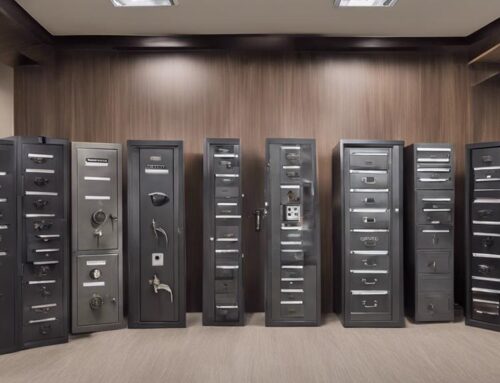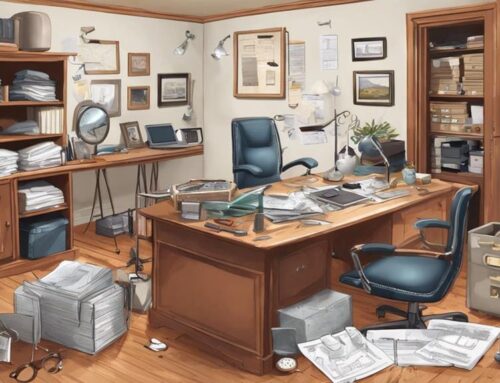In a world where valuables are constantly at risk, it’s crucial to understand the vulnerabilities of safes. Contrary to popular belief, no safe is truly impenetrable. Thieves, armed with tools like crowbars and angle grinders, are adept at breaking in.
That’s why secrecy and creativity are key. This article delves into seven lesser-known aspects of safes, from the importance of investing in quality to strategies for hiding and concealing them.
Stay one step ahead and protect your valuables with knowledge and ingenuity.
The Vulnerabilities of Safes
Thieves commonly steal the safe to open it later, which highlights the vulnerabilities of even the most secure safes. When considering the vulnerabilities of safes, it is important to be aware of the common methods used by thieves to break into them.
Prying the safe open with a crowbar is a common method, as is cutting into the safe with an angle grinder. Torch attacks, although rare, can also be used on expensive safes.
Factors to consider when choosing a safe include investing in a high-quality safe that has thicker and stronger metal. Cheaper safes may have weaker doors and bodies, making them more susceptible to break-ins.
It is crucial to secure the safe and make it hard to find, as well as to bolt the safe to the ground, although this can still be defeated by prying.
The Cost and Quality of Safes
Expensive safes offer thicker and stronger metal, providing better protection against drills and torch attacks. Cheaper safes tend to have weaker doors and bodies, making them more susceptible to break-ins.
On the other hand, investing in a high-quality safe ensures that your valuable possessions are well-protected. These safes are constructed using superior materials that defend against drilling and torch attacks.
It is important to consider the level of security you require and balance it with your budget. Comparing safe quality and price is crucial to finding the right safe for your needs. Remember, the amount you pay directly relates to the level of protection you receive.
The Importance of Secrecy
Concealing the existence of a safe adds an extra layer of security, making it harder for potential burglars to locate and access valuable items. Secrecy plays a vital role in safe security, influencing the mindset of burglars and affecting their targeting strategies. Understanding the psychology of burglars can shed light on how secrecy impacts their decision-making.
Here are two key points to consider:
- Secrecy and Safe Security:
- Keeping the existence of a safe a secret reduces the chances of becoming a target.
- Sharing information about the safe increases vulnerability and puts valuables at risk.
- Impact on Burglars’ Targeting:
- Burglars rely on information and intelligence gathering to choose their targets.
- Lack of knowledge about the presence of a safe can deter burglars and make them move on to easier targets.
Hiding and Concealing the Safe
Placing the safe behind a false wall or in a hidden compartment provides an additional layer of protection against potential burglars. By utilizing these hiding techniques and concealment methods, individuals can enhance the security of their valuables and ensure their freedom from theft. One effective way to hide a safe is by using a false wall, where the safe is concealed behind a disguised panel. Another method is to create a hidden compartment within a piece of furniture or the floor, making it difficult for burglars to locate the safe. To draw the audience in and keep them interested, here is a table showcasing different hiding techniques and concealment methods:
| Hiding Techniques | Concealment Methods |
|---|---|
| False wall | Hidden compartment |
| Secret room | Camouflaged safe |
| Underneath flooring | Behind a painting |
| Inside a piece of furniture | Concealed behind a mirror |
With these techniques and methods, individuals can protect their valuables and maintain their freedom by keeping their safe hidden and secure.
Inaccessibility for Enhanced Security
Hiding the safe in an area that is difficult to access, such as inside a wall or beneath the flooring, adds an extra layer of security to protect valuable items. By making the safe invisible and inaccessible, thieves will struggle to find and break into it. Inaccessibility is particularly beneficial for infrequently used items that need to be kept secure. Unique hiding spots, like inside a hollowed-out bookshelf or behind a false electrical panel, can further enhance the security of the safe.
However, it’s important to consider the pros and cons of wall safes. While wall safes provide a hidden and discreet storage option, they may be more vulnerable to discovery during renovations or if the wall is compromised. Additionally, wall safes may have limited space and may not be suitable for larger items.
Creativity in Safe Placement
Utilizing unconventional hiding spots and thinking outside the box can greatly enhance the security of a safe. When it comes to safe placement, creativity is key. Consider areas in your house that you avoid cleaning, as these can serve as unexpected hiding places.
Hide the safe where no one would expect it, such as inside a hollowed-out book or disguised as a piece of furniture. Innovative hiding techniques can make it extremely difficult for criminals to find and break into your safe.
Overall Importance and Strategies for Safes
Investing in a high-quality safe is paramount to ensuring the security of valuable possessions. A better safe offers numerous benefits, including increased protection against theft and enhanced peace of mind.
Balancing discretion, creativity, and knowledge is crucial when it comes to safeguarding your valuables.
Benefits of investing in a better safe include:
- Increased durability and resistance to break-ins
- Advanced features such as fireproofing and waterproofing
Balancing discretion, creativity, and knowledge is essential for effective safe usage. By maintaining secrecy about the existence of your safe, you reduce the chances of becoming a target. Concealing the safe in unexpected places, such as inside walls or floors, adds an extra layer of security. Additionally, thinking outside the box and utilizing creativity in safe placement can further thwart potential thieves.
Frequently Asked Questions
Can a Safe Be Completely Invulnerable to All Types of Break-In Methods?
A safe cannot be completely impenetrable or bypass all security measures. While high-quality safes offer better protection, determined thieves can still find ways to break into them given enough time and the right tools.
How Can I Ensure That My Safe Is Securely Bolted to the Ground?
To ensure secure anchoring, there are various ways to anchor a safe. Professional installation provides added benefits, ensuring proper placement and minimizing vulnerabilities. Protect your valuables with expert guidance and peace of mind.
What Are Some Effective Ways to Conceal the Existence of a Safe in My Home?
Some effective ways to conceal the existence of a safe in a home include creative safe placement and using alternative hiding spots. By thinking outside the box and avoiding obvious places, one can make it difficult for criminals to find and break into the safe.
Can Hiding a Safe Inside a Wall or Floor Make It More Susceptible to Damage?
Hiding a safe inside a wall or floor has its pros and cons. On one hand, it adds an extra layer of security by making the safe harder to find. On the other hand, it can make the safe more susceptible to damage if the wall or floor is compromised. The best materials to use for hiding a safe in a wall or floor are ones that provide strong concealment without compromising the structural integrity of the hiding place.
Are There Any Disadvantages to Using Creativity in Safe Placement?
Disadvantages of creative safe placement include the risk of forgetting the location and difficulty accessing the safe in emergency situations. However, creative ideas for small spaces include using false objects or integrating the safe into furniture for added security.


